1. Picture drawn when the lady-seeker was felicitated for attaining spiritual level of 61% by Pujya Satyavan Kadam (Sanatan’s 5th saint)
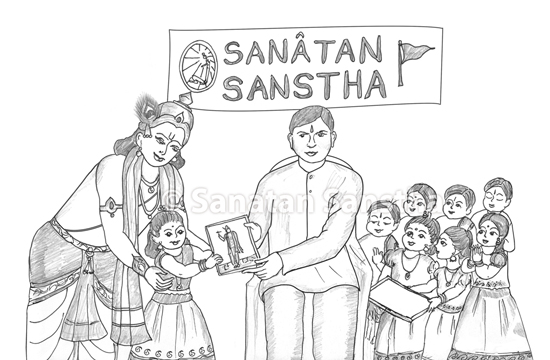
On 3.9.2012 Pujya Satyavan Kadam felicitated me for attaining the spiritual level of 61%. Undoubtedly it is the most important day in my life. The picture depicts that, ‘Like a proud father, Shrikrushṇa is standing behind me’. Upon seeing the happiness of Shriguru and the seekers, I also felt very happy. (This picture exhibiting balakbhav [Childlike emotion] was drawn by me a day after the felicitation.) – Mrs Uma Ravichandran, Chennai, Tamil Nadu. (4.9.2012, 4 a.m.)
A. The lady-seeker felt that there was something amiss in the picture
depicting Shrikrushṇa and Pujya Satyavan Kadam, because she knew
the picture would not be complete without showing the seekers in Chennai,
who had helped her in her spiritual journey and hence, she drew their picture too
While drawing the picture of my felicitation, I drew my picture along with Shrikrushṇa and Pujya Satyavan Kadam; however, I realised that the picture would not be complete without the seekers in Chennai, who had helped in my spiritual journey. The next day, while leaving for Ramnathi, in the train I also drew the picture of Chennai’s active seekers Mr Kashinath Shetty, Mrs Rupa Shetty, Mr Prabhakaran, Mrs Sugandhi, Mrs Komala, Mr Premnath and Mrs Ragini. – Mrs Uma Ravichandran, Chennai, Tamil Nadu.
B. Distinctive feature of the picture – The lady-seeker
clearly depicted through the ornament hanging from Shrikrushṇa’s crown that
Krushṇatattva was the happiest at the lady-seeker’s achievement of 61% spiritual level
When the lady-seeker accepts a gift from Pujya Satyavan Kadam for attaining the spiritual level of 61%, Shrikrushṇa is shown standing behind the lady-seeker exhibiting balakbhav like a father figure, and only in this picture, an ornament is shown hanging from Shrikrushṇa’s crown. Through this aspect, the lady-seeker has expressed that Krushṇatattva (Shrikrushna Principle) was the happiest at the event. In no other picture such an ornament has been shown hanging over the ear from the crown; because, the ornament is tucked in the crown as a sign of supreme happiness. – Mrs Anjali Gadgil, Sanatan Ashram, Goa. (12.9.2012)
2. Picture depicting Mrs Uma’s state
before and after commencing sadhana (Spiritual practice)
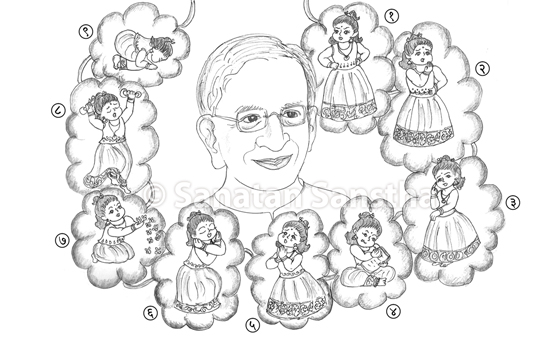
A. Explanation of the picture
While speaking about sadhana on 20.1.2013, we (Chennai’s two lady-seekers, Mrs Komala and Mrs Vinutha, and I) had a question about the efforts necessary to enhance bhav (Spiritual emotion) and reduce personality defects. Bhagawan Shrikrushṇa made me aware of 9 types of bhav and their stages.
Before commencing sadhana
1. Thought that ‘I am always correct’
Before initiation into sadhana we think ‘I am always correct’ and hence, at times we get angry and react. We never understand that we are thinking in this manner due to our strong ego.
After commencing sadhana
1. Awareness of defects and ego
After starting to perform sadhana, we understand that anger is the manifestation of our personality defects and ego. Though we cannot control anger, we are at least aware of the fact that we are getting angry, and anger is a personality defect in us. That very moment, our notion that ‘I am always correct’ is shattered.
2. Beginning of introversion
When awareness of anger dawns on us, introversion begins. We begin to contemplate on what is the root cause of anger, how deep is the defect and what efforts are necessary to overcome it.
3. Increase in the curiosity about learning
After introversion sets in, the curiosity to learn from an incident, circumstance and inanimate objects increases. In every incident, no matter how difficult it is, we think that God has created for us to learn something. Instead of getting angry, our attitude of learning increases.
4. Feeling of remorse for mistakes and awareness that Shrikrushṇa is functioning through seekers who point out mistakes
We will feel remorse for mistakes when we are able to go to the root cause of the defect. Though due to intense ego and personality defects the mistakes are committed repeatedly, Bhagawan Shrikrushṇa does not desert me. He is an ocean of compassion. He creates new situations, makes me face hard circumstances, helps me wriggle out of circumstances and teaches me repeatedly without getting bored. I become aware that Shrikrushṇa is functioning through seekers who get angry, quarrel with me and point out my mistakes. It is He who conducts the examination and watches calmly whether I pass the examination.
5. By seeking forgiveness, ego begins to reduce
At this stage, ego begins to reduce. As we feel remorse for our mistakes, we also seek forgiveness. The mistakes are accepted and forgiveness is sought from others.
6. Awakening of bhav of gratitude
Thereafter, acceptance level by the mind is so much that we develop bhav of gratitude for those who point out mistakes. With realisation that it is due to their help that we are becoming aware of ego, we express gratitude to them.
7. Being in a constant state of bhav
We become aware of the shower of God’s grace through the medium of Shriguru and the mind remains in a constant state of bhav. Our mind is overwhelmed due to Shriguru’s intense vatsalyabhav (Spiritual emotion of maternal love). The mind makes efforts to be worthy of this shower of Priti (Unconditional love, spiritual love devoid of expectations). Thereafter this awareness dawns on us – ‘No matter how much effort we make, we cannot repay His debt’.
8. Offering ourselves completely at the Holy feet of God
Thereafter, there is no alternative but to adopt an attitude of complete surrender at the lotus feet of God. Since I do not have anything to offer to God, I pray for complete offering of my own self, ‘O God ! Please accept me and uplift me spiritually. Create the ability in me to be worthy of Your grace. Get everything done through me. O God ! I do not understand what I should ask from You, what I should do, how I should speak to You and what should be the direction of thoughts. I pray at Your Holy feet that may my existence be destroyed completely and may Your Divine existence be created in my place.
B. Analysis of the picture
In this picture nine types of bhav are depicted.
1. Getting angry due to personality defects and ego
2. Being stunned after awareness of personality defects
3. Introversion
4. State of learning
5. Feeling of remorse
6. Seeking forgiveness
7. Bhav of gratitude
8. Experience of constant state of bhav
9. Creation of a complete bhav of surrender
C. Spiritual experience
While drawing this picture, I did not know what I was drawing; however, unknowingly at every stage I drew the picture in a flower and connected every flower to the flower of the next stage. Later, I realised that it depicted the ‘Rakshabandhan of Sanatan Sanstha’. I realised that when we are connected with God, our worldly relationships get wiped off gradually and it is He who protects us from everything.
– Mrs Uma Ravichandran, Chennai (22.1.2013, 12.45 p.m.)

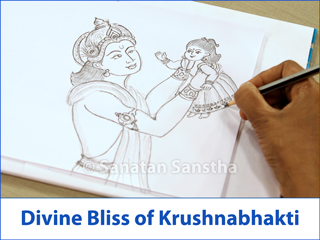 Pictures of Balakbhav bestowing the Divine Bliss of Krushnabhakti
Pictures of Balakbhav bestowing the Divine Bliss of Krushnabhakti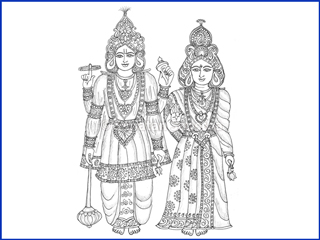 Picture of Shri Lakshminarayan at Jaipur drawn on the day of Ramnavami
Picture of Shri Lakshminarayan at Jaipur drawn on the day of Ramnavami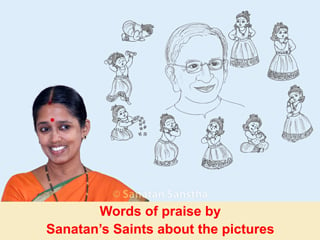 Words of praise by Sanatan’s Saints about the pictures depicting Balakbhav
Words of praise by Sanatan’s Saints about the pictures depicting Balakbhav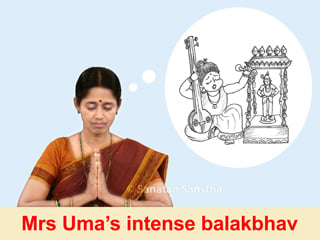 Spiritual experiences of gopis upon seeing the pictures drawn by Mrs Uma
Spiritual experiences of gopis upon seeing the pictures drawn by Mrs Uma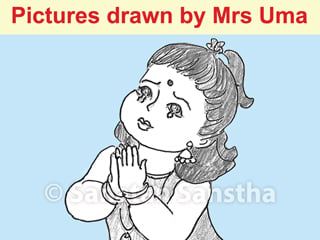 Characteristics perceived by Sanatan’s seeker-artists about pictures drawn by Mrs Uma and associated spiritual experiences
Characteristics perceived by Sanatan’s seeker-artists about pictures drawn by Mrs Uma and associated spiritual experiences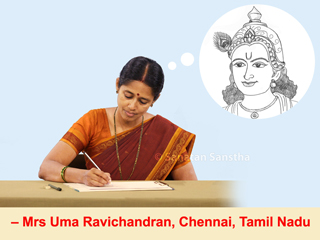 Picture depicting spiritual experience pertaining to H.H. Dr Athavale (Part 2)
Picture depicting spiritual experience pertaining to H.H. Dr Athavale (Part 2)